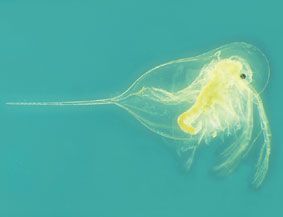Descriptive Features: single large black compound eye
small ocellus may be present
2 pairs of antennae
antennules, 1st pair of antennae, small and sensory
2nd pair of antennae large, segmented, branched and locomotory
bivalved carapace encasing trunk (thorax plus abdomen) limbs and body, usually not head
5 - 6 pairs of trunk limbs
1st 2 pairs prehensile, others leaf-like (except Sidiidae, which are all leaf-like)
body terminates in large postabdomen, commonly bearing 2 claws
Total length: < 250 µm – 4 - 6 mm
|

|
Daphnia carinata |
|
|
Ecology: Instream habitat: The majority of water fleas are found in sheltered littoral and benthic areas of still or slow flowing, temporary or permanent waters, amongst macrophytes.
Feeding ecology: Water fleas may be bacterivorous, herbivorous or detritivorous grazing on phytoplankton, algae, bacteria or dead plant material. In turn macroinvertebrates and fish eat water fleas. The trunk limbs of cladocerans beat rapidly inside the carapace valves creating currents for food capture and respiratory oxygen supply. The postabdominal claw flicks debris away from the feeding chamber also cleaning setae on the trunk limbs.
Habit:
Life history: Females dominate cladoceran populations. Population peaks are reached in the presence of algal blooms with hundred fold increases possible. Females reproduce without males (parthenogenesis). Eggs are incubated in a brood chamber and released as neonates, miniature versions of adults. A new clutch of eggs (up to three hundred) is produced after each moult. Declining environmental conditions such as low food, over crowding or seasonal changes, initiates sexual reproduction. Egg clutches with both males and females are produced. When these eggs are subsequently fertilised by males they develop into resting eggs that are capable of withstanding drying, freezing and digestive enzymes of other animals. These ephippial eggs are resistant due to a thickened and pigmented section of the carapace, known as the ephippium. During this resting stage the eggs are dispersed long distances by wind, birds and furred animals. Presence of water along with seasonal changes breaks the resting stage. The life span of cladocerans is about fifty days with optimum reproductive capacity being reached at fourteen to fifteen days.
|
Information Sources: van Damme et al. 2007a, 2007b, Shiel 1995, Ingram et al 1997, Hawking & Smith 1997, Davis & Christidis 1997, ABRS 2008
Key to Families: Shiel 1995, Ingram et al 1997 (still waters, SE Aus, incomplete)
Key to Genera: Shiel 1995 (Chydoridae, Daphniidae, Macrothricidae, Moinidae, incomplete)
Key to Species: Kotov et al. 2009 (Bosminidae: Bosmina, males, world) (maybe more than 1 species in Aus)
Shiel 1995 (Chydoridae: Chydorus, Daphniidae: Ceriodaphina, Moinidae: Moina, incomplete)
Hebert & Wilson 2000 (Daphniidae: Daphnia as Daphniopsis, ephippial females)
Benzie 1988 (Daphniidae: Daphnia)
Timms 1989 (Daphniidae: Simocephalus)
|